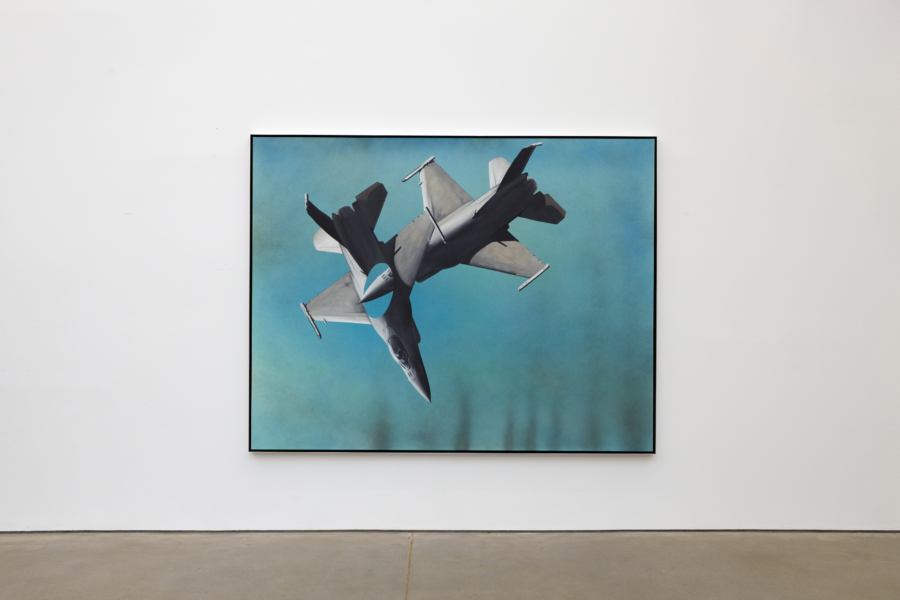April 23, 2024

Installation view, Calvin Marcus, Give Up the Ghost, Karma, New York, NY
Calvin Marcus, in his mid-thirties, is offering a small group of large paintings of jets, mostly military in nature. Marcus, based in Los Angeles and showing for the first time at Karma, follows a theme here, in which the planes are usually presented as tools of aggression.
The larger meaning of these jets is not easily known. Is it a warning regarding the military/industrial complex so dominant in our culture? Or is it simply a celebration of technology, in which the streamlined cockpit of the planes, pointed at the end, along with the sharp angle of the wings, are meant to remind us of advances in aviation speed and technology that are nearly beyond belief.
What kind of messages do they send? The title of the exhibition, “Give Up the Ghost,” an idiom for the death of a person, reminds us that jets are often used for military purposes–and the missiles they bear are capable of destroying large numbers of people in a moment. But Marcus’s paintings usually result in attractive images–even if the planes are meant to carry death. The beauty of the jets is at odds with the function they are meant to fulfill.
In an untitled work done in 2023, the artist presents his audience with the underside of a white jet pointed upward. Its white wings hold four slender missiles on both wings close to the plane’s fuselage, while the ends of the wings support two larger missiles. The bottom end of the plane has two exhausts, and shadows in gray are found all over the plane’s body. The esthetic beauty of the image is likely intensified by its capability for damage on a large scale. This strong show describes how beauty is intensified by fear.
A particularly idiosyncratic rendering by Marcus concerns four planes twisted together, as if made of a pliable material. The cockpits hang downward, while the tails of the jets, which rise upward, are joined so that they suggest leaves (or the gestalt of an old-fashioned bomb). But even if the image seems taken from nature, we can see the windows of the cockpits, while the military off white of the plane reminds us of its real purpose. But the image undermines rational military function.
Twisted as the four jets are into a facsimile of the humble turnip, the idea that jets might possess the elasticity of a rubber band would undermine the formidable authority associated with their purpose and facture in rigid aluminum. Marcus appears to follow the machines pretty closely in form if not in thematic implication. So the two genres of perception–function and motive convey a disconnect when they are considered together. Yet it is hard to say if the purpose is removed from the appearance of the planes. Consequently, the gestalt becomes attractively strange. Here, surrealism, the result of a disfigured image, undermines the usual expectations we have of Air Force jets.
The final image to be discussed, a composition involving the intersect of two sleek planes painted in 2023, shows the aircraft at right angles to each other. The one on the left faces downward, but it is only the mask of a jet–its top half exists alone. This jet seems destined for oblivion, and we know only the upper half exists because the brown background can be seen through the open window of its cockpit. Also visible though that window is the sharp nose of the second jet – the latter cuts through the same open space.
The meaning of these enigmatic images is difficult to define. There is the sheer beauty of the jets’ forms, which are sharp and streamlined. There is also the more malevolent purpose of their existence: the deadly chaos of the missiles.
In consequence, one is hard put to read a moral narrative into so seemingly pure a description of these machines. Marcus’s esthetic is perfect but deadly. Here, in America, the planes are active and to be mortally feared but Marcus is a painter, not a moralist. If we read a malicious intention into the planes, we are adding more than we what we see–at least on the surface. But, clearly, the United States, armed to the teeth with weapons of mass destruction, does not forget to use them. Marcus’s paintings are thus both beautiful and chilling.



